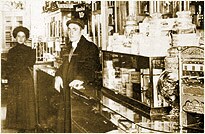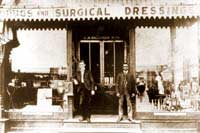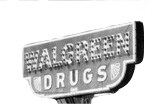Our Past
"By making certain drug items himself, Mr.Walgreen was able to ensure their high quality, yet offer them at lower prices than comparable merchandise."
Yet Chicago in 1893, the year of Walgreen's arrival, was far from promising for a future drugstore entrepreneur. More than 1,500 drugstores already competed for business (many exceedingly successful) and customers had no lack of choice. Given this stiff competition, Walgreen's ultimate achievements are all the more remarkable.
Determined not to rely on his family's resources to sustain himself, Walgreen resolved to achieve success on his own. In fact, faced with the prospect of being completely broke shortly after his arrival in Chicago, Walgreen defiantly tossed his few remaining pennies into the Chicago River, forcing himself to commit to his profession and a lifetime of perseverance and hard work.
A lesson well learned - and never forgotten - by Walgreen
In a series of jobs with Chicago's leading pharmacists - Samuel Rosenfeld, Max Grieben, William G. Valentine and, most importantly, Isaac W. Blood - Walgreen grew increasingly knowledgeable - and increasingly dissatisfied - with what he saw as old-fashioned, complacent methods of running a drugstore. Where was the desire to provide superb customer service? Where were the innovations in merchandising and store displays? Where was the selection of goods that customers really wanted ... and could afford? Where was the sense of trying to understand, please and serve the many needs of drugstore customers? And, most of all, where was the commitment to providing genuine value to the customer?
The answer was obvious: Walgreen had to open his own pharmacy.
However, it was not until 1901 that Walgreen was able to put together enough money for the down payment on his pharmacy. He wanted to buy the store in which he was working, owned by Isaac Blood. Walgreen had been not only a trusted employee, but a valuable business advisor as well. Yet even in view of Walgreen's outstanding business counsel on Blood's behalf, Blood was unyielding in the sale to Walgreen, raising his asking price from $4,000 to $6,000. Though it would take years for Walgreen to pay off the loan he signed for the purchase, he went ahead. He was now his own man and well on his way to building one of the most remarkable businesses in America.


Walgreen's drugstore was located in Barrett's Hotel at Cottage Grove and Bowen Avenue on Chicago's South Side. Originally built in anticipation of the 1893 World's Columbian Exposition, this was a thriving neighborhood. The store, however, was struggling. Dim, poorly merchandised and unwelcoming, it presented Walgreen with the first real challenge to his ideas on store layout, selection, service and pricing.
By every account, Walgreen succeeded brilliantly, simply by practicing what he preached and instituting what he felt were clearly needed innovations. New, bright lights were installed to create a cheerful, warm ambiance in the store. Each customer was personally greeted by Walgreen or his colleague, Arthur C. Thorsen. Aisles were widened, creating a spacious, airy, welcoming feeling - a far cry from the cramped interiors of other drugstores. The selection of merchandise was improved and broadened, including pots and pans (unheard of in a drugstore!) at the bargain price of 15¢ a piece! Prices were kept fair and reasonable. The quality of Walgreen's pharmaceutical compounds (he had become a registered pharmacist in 1897) met the very highest standards for purity and freshness. Efficiency was increased. But the most dramatic change Walgreen instituted was a level of service and personal attention unequaled by virtually any other pharmacy in Chicago. And this was exemplified by Walgreen's famous...
